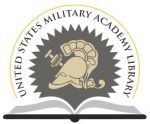Welcome to USMA Athena
USMA Athena is a secure digital service managed by the United States Military Academy Library to make the work of USMA scholars freely available, while also ensuring these resources are organized to preserve the legacy of USMA scholarship. The mission of USMA Athena is to showcase the academic impact and intellectual capital that has become synonymous with the celebrated heritage of educational prowess attributed to the Long Gray Line. Scholarship submitted to USMA Athena benefits from added visibility and discoverability via Google Scholar in addition to the use of persistent URLs that will provide enduring access to the work over time.
Recent Submissions
Item OACOK, OKOCA, or OCOKA? Reframing Terrain Analysis for Cyberspace(Gray Space: Cyber & Electromagnetic Warfare Journal, 2025-07)We contend that the cyberspace domain has different dynamics than the land domain, which justifies a distinct framework for analyzing cyber terrain in military operations. We first provide a characterization of cyberspace as a warfighting domain that is constructed, interconnected, pervasive, dynamic, complex, and opaque. Given these unique characteristics, we identify specific items that cyber planners should consider. These items are grouped into three categories — the organizational context, the network design and functioning, and the security posture of the network — and include questions that can guide mission analysis. The article is informed by our experiences conducting both land domain and cyberspace operations, as well as our research while at the Army Cyber Institute.Item Unseen Threats: The Privacy Risks of Data Collection in Government Fleet Vehicles(3rd USENIX Symposium on Vehicle Security and Privacy, 2025-08)Data collection and transmission in connected vehicles pose privacy concerns when the vehicles are part of a government-operated fleet. U.S. Army leaders and personnel rely on the General Services Administration's (GSA) fleet vehicles for their day-to-day duties. These connected vehicles may introduce privacy risks to individuals employed in a national security context by collecting and transmitting sensitive data. This study investigates connected vehicles belonging to the GSA fleet. Our objective is to analyze the data collected by these vehicles, capture the data, and analyze their transmissions to external parties.Item Overcoming Social Media API Restrictions: Building an Effective Web Scraper(Workshop Proceedings of the 18th International AAAI Conference on Web and Social Media, 2024)As social media platform application programming interfaces (APIs) are becoming more restrictive and costly to use, there is a considerable risk that researchers will be unable to address research problems related to online discourse. This paper presents a detailed examination of an effective approach to scraping X (formerly Twitter) data, leveraging the Selenium WebDriver for automated interaction with web pages. This technique circumvents the limitations of X’s dynamic content generation and JavaScript-dependent interface, providing a robust alternative to traditional API-based data retrieval methods. By emulating human navigation patterns, this method offers insights into extracting real-time social media data, including tweets, likes, and retweets, which are crucial for various analytical applications.Item The New Insider Threat: How Commercially Available Data can be used to Target and Persuade(Managing Insider Risk and Organizational Resilience (MIROR) Journal, 2024)This paper examines how commercially available information can be weaponized by malicious actors to identify, target, and manipulate individuals with insider access to sensitive information. Drawing on empirical research about insider threat correlates, our study offers analysis of a dataset from Microsoft’s Xandr advertising platform containing over 650,000 audience segments from 93 data brokers. The findings demonstrate that the same variables organizations use to detect potential insider threats—such as psychological predispositions, life stressors, ideological positions, and motivations—can also be reverse-engineered by malicious actors from commercial data to target vulnerable members of the United States military and government. This research underscores the risks posed by the unregulated data brokerage ecosystem which commodifies personal information, and its national security implications.Item Death by a Thousand Cuts: Commercial Data Risks to the Army(Army Cyber Institute, 2023-12)This report outlines the force protection challenges related to publicly available information (PAI), and specifically highlights commercial data exposed through data brokers. The rapid, widespread, and low-cost availability of data about personnel poses significant operations security (OPSEC) and force protection vulnerabilities for the Army. The recommendations for action included in this report emphasize organizational mitigation actions, as opposed to individual training or national-level policy changes. These are actions that the Army can implement with existing authorities – in absence of federal data privacy legislation or DoD directive – to protect the force while preserving the civil liberties and privacy of its members. While many of the analytic technologies outlined in this report are touted as the Industry standard for marketing, they are widely viewed as invasive by privacy and civil liberties experts – while granting users little transparency or control over what data is collected about them.
Communities in USMA Athena
Select a community to browse its collections.
